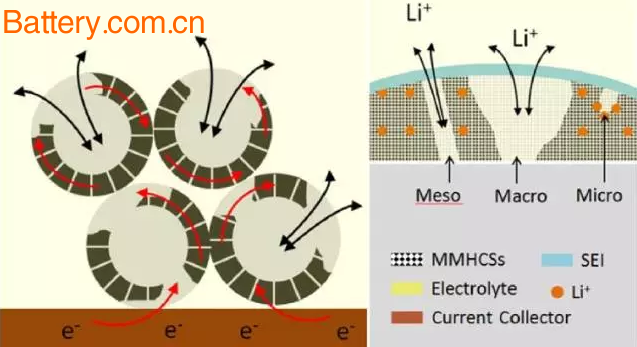Graphite negative electrode material is lithium-ion batteries most commonly used anode material, in the process of the lithium ion battery, the with Li + reaction of a compound of LiC6 is generated, the theoretical specific capacity of 372mAh / g, the current capacity of the highest graphite anode materials actual ratio The capacity is 360 mAh/g, which is close to the theoretical capacity, while most graphite anode materials have a capacity of 300 mAh/g. With the gradual increase of the specific energy of lithium-ion batteries, traditional graphite anode materials, such as natural graphite and artificial graphite, can no longer meet the needs of high-energy lithium-ion batteries, so many high-capacity anode materials have been developed one after another, of course, graphite materials. There is no waiting for it, and a variety of modification technologies have been developed. Among them, the most effective and most attractive are the “nitrogen-doped graphite technology†and the “mesoporous carbon technologyâ€. These two modification methods are greatly improving the graphite material. On the basis of specific capacity, it does not reduce the cycle performance of the material, so it has a good application prospect. Recently, Xinyang Yue et al. of Beijing Institute of Technology developed a microporous-mesoporous hollow carbon microsphere lithium ion battery anode material based on mesoporous carbon technology. The specific surface area of ​​the material is up to 396 m2/g, and the material not only has high capacity characteristics. And with good cycle performance, at a current density of 2.5 A / g, the specific capacity of 530 mAh / g is still maintained after 1000 cycles. The rate performance of the material is also very shocking. At a current density of 60 A/g (approximately 100 C), the specific capacity of the material is still up to 180 mAh/g. In the study, Xinyang Yue used 370nm silicon microspheres as template, dopamine as carbon source, PEO-PPO-PEO (P123) as pore forming medium, Ar protection roasting at 400 °C for 3h, then 800 °C for 3h, and finally 20%. The HF etches micropores on the surface of the hollow carbon microspheres and removes the silicon template from the material. After the final cleaning and vacuum drying, a microporous-mesoporous hollow carbon microsphere material was obtained. In the SEM photograph, the material was microspheres uniformly dispersed with a diameter of about 400 nm, and the surface exhibited micropores formed by HF etching. The hollow structure of the material was observed by TEM microscopy. Electrochemical tests show that the material can obtain a current density of 624 mAh/g at a current density of 0.5 A/g, which is much higher than the theoretical specific capacity of the graphite material of 372 mAh/g. The additional capacity is mainly due to defects in the material. produced. However, the irreversible capacity of the material is high, reaching 1081 mAh/g, which is mainly due to the large specific surface area of ​​the material, which causes the electrolyte to decompose more and consume more Li during the formation of the SEI film. Although the material has a high first irreversible capacity, the material has good cycle performance. The material has an initial discharge capacity of 646 mAh/g, and the capacity of the cycle is reduced to 502 mAh/g in 50 cycles, but then the specific capacity begins to rise. The cycle capacity is 563 mAh/g for 400 cycles, and the cycle capacity is still 500 mAh/g or more. The most outstanding performance of this material is the rate performance at 1 A / g, 2.5 A / g, 5 A / g, 10 A / g, 20 A / g, 40 A / g and 60 A / g current density The specific capacity of the material reached 495 mAh/g, 382 mAh/g, 301.3 mAh/g, 254.4 mAh/g, 206.5 mAh/g, 190.7 mAh/g and 189.3 mAh/g, showing good magnification. Performance, ideal for high power lithium-ion batteries. At present, the biggest problem of the material is that the preparation cost is too high, the tap density is low, and it is difficult to commercialize the application, and the problem that the material's first irreversible capacity is too high can be solved by a lithium-retaining technology such as a negative electrode. At present, the method is still only at the laboratory level, and further research is needed to reduce costs and improve the performance of materials. A needle roller bearing is a special type of roller bearing which uses long, thin cylindrical rollers resembling needles. Ordinary Roller Bearings' rollers are only slightly longer than their diameter, but needle bearings typically have rollers that are at least four times longer than their diameter.Like all bearings, they are used to reduce the friction of a rotating surface. Needle Roller Bearings,Steel Needle Roller Bearing,Double Row Needle Roller Bearing,High Precision Needle Roller Bearings Ningbo Ritbearing Imp & Exp Co.,Ltd. , http://www.ritbearingchina.com

Compared to Ball Bearings and ordinary roller bearings, needle bearings have a greater surface area in contact with the races, so they can support a greater load. They are also thinner, so they require less clearance between the axle and the surrounding structure.
Needle bearings are heavily used in automobile components such as rocker arm pivots, pumps, compressors, and transmissions. The drive shaft of a rear-wheel drive vehicle typically has at least eight needle bearings (four in each U joint) and often more if it is particularly long, or operates on steep slopes.
High performance graphite anode material: hollow carbon microspheres